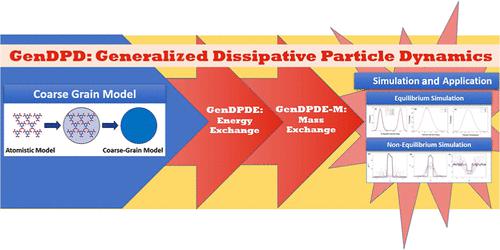当前位置:
X-MOL 学术
›
J. Chem. Theory Comput.
›
论文详情
Our official English website, www.x-mol.net, welcomes your
feedback! (Note: you will need to create a separate account there.)
Generalized Energy-Conserving Dissipative Particle Dynamics with Mass Transfer. Part 2: Applications and Demonstrations
Journal of Chemical Theory and Computation ( IF 5.7 ) Pub Date : 2022-11-18 , DOI: 10.1021/acs.jctc.2c00453 Martin Lísal 1, 2 , Josep Bonet Avalos 3 , James P Larentzos 4 , Allan D Mackie 3 , John K Brennan 4
Journal of Chemical Theory and Computation ( IF 5.7 ) Pub Date : 2022-11-18 , DOI: 10.1021/acs.jctc.2c00453 Martin Lísal 1, 2 , Josep Bonet Avalos 3 , James P Larentzos 4 , Allan D Mackie 3 , John K Brennan 4
Affiliation

|
We present the second part of a two-part paper series intended to address a gap in computational capability for coarse-grain particle modeling and simulation, namely, the simulation of phenomena in which diffusion via mass transfer is a contributing mechanism. In part 1, we presented a formulation of a dissipative particle dynamics method to simulate interparticle mass transfer, termed generalized energy-conserving dissipative particle dynamics with mass transfer (GenDPDE-M). In the GenDPDE-M method, the mass of each mesoparticle remains constant following the interparticle mass exchange. In part 2 of this series, further verification and demonstrations of the GenDPDE-M method are presented for mesoparticles with embedded binary mixtures using the ideal gas (IG) and van der Waals (vdW) equation-of-state (EoS). The targeted readership of part 2 is toward practitioners, where applications and practical considerations for implementing the GenDPDE-M method are presented and discussed, including a numerical discretisztion algorithm for the equations-of-motion. The GenDPDE-M method is verified by reproducing the particle distributions predicted by Monte Carlo simulations for the IG and vdW fluids, along with several demonstrations under both equilibrium and non-equilibrium conditions. GenDPDE-M can be generally applied to multi-component mixtures and to other fundamental EoS, such as the Lennard-Jones or Exponential-6 models, as well as to more advanced EoS models such as Statistical Associating Fluid Theory.
中文翻译:

具有质量传递的广义能量守恒耗散粒子动力学。第 2 部分:应用和演示
我们提出了一个由两部分组成的系列论文的第二部分,旨在解决粗粒粒子建模和模拟计算能力方面的差距,即模拟通过质量传递扩散是一种促成机制的现象。在第 1 部分中,我们提出了一种用于模拟粒子间传质的耗散粒子动力学方法的公式,称为广义能量守恒耗散粒子动力学传质 (GenDPDE-M)。在 GenDPDE-M 方法中,每个中粒子的质量在粒子间质量交换后保持不变。在本系列的第 2 部分中,使用理想气体 (IG) 和范德华 (vdW) 状态方程 (EoS) 进一步验证和演示了 GenDPDE-M 方法,用于嵌入二元混合物的中粒子。第 2 部分的目标读者是从业者,其中介绍和讨论了实施 GenDPDE-M 方法的应用和实际考虑,包括运动方程的数值离散算法。GenDPDE-M 方法通过再现 IG 和 vdW 流体的蒙特卡罗模拟预测的粒子分布以及平衡和非平衡条件下的几个演示来验证。GenDPDE-M 通常可应用于多组分混合物和其他基本 EoS,例如 Lennard-Jones 或 Exponential-6 模型,以及更高级的 EoS 模型,例如统计关联流体理论。包括运动方程的数值离散算法。GenDPDE-M 方法通过再现 IG 和 vdW 流体的蒙特卡罗模拟预测的粒子分布以及平衡和非平衡条件下的几个演示来验证。GenDPDE-M 通常可应用于多组分混合物和其他基本 EoS,例如 Lennard-Jones 或 Exponential-6 模型,以及更高级的 EoS 模型,例如统计关联流体理论。包括运动方程的数值离散算法。GenDPDE-M 方法通过再现 IG 和 vdW 流体的蒙特卡罗模拟预测的粒子分布以及平衡和非平衡条件下的几个演示来验证。GenDPDE-M 通常可应用于多组分混合物和其他基本 EoS,例如 Lennard-Jones 或 Exponential-6 模型,以及更高级的 EoS 模型,例如统计关联流体理论。
更新日期:2022-11-18
中文翻译:

具有质量传递的广义能量守恒耗散粒子动力学。第 2 部分:应用和演示
我们提出了一个由两部分组成的系列论文的第二部分,旨在解决粗粒粒子建模和模拟计算能力方面的差距,即模拟通过质量传递扩散是一种促成机制的现象。在第 1 部分中,我们提出了一种用于模拟粒子间传质的耗散粒子动力学方法的公式,称为广义能量守恒耗散粒子动力学传质 (GenDPDE-M)。在 GenDPDE-M 方法中,每个中粒子的质量在粒子间质量交换后保持不变。在本系列的第 2 部分中,使用理想气体 (IG) 和范德华 (vdW) 状态方程 (EoS) 进一步验证和演示了 GenDPDE-M 方法,用于嵌入二元混合物的中粒子。第 2 部分的目标读者是从业者,其中介绍和讨论了实施 GenDPDE-M 方法的应用和实际考虑,包括运动方程的数值离散算法。GenDPDE-M 方法通过再现 IG 和 vdW 流体的蒙特卡罗模拟预测的粒子分布以及平衡和非平衡条件下的几个演示来验证。GenDPDE-M 通常可应用于多组分混合物和其他基本 EoS,例如 Lennard-Jones 或 Exponential-6 模型,以及更高级的 EoS 模型,例如统计关联流体理论。包括运动方程的数值离散算法。GenDPDE-M 方法通过再现 IG 和 vdW 流体的蒙特卡罗模拟预测的粒子分布以及平衡和非平衡条件下的几个演示来验证。GenDPDE-M 通常可应用于多组分混合物和其他基本 EoS,例如 Lennard-Jones 或 Exponential-6 模型,以及更高级的 EoS 模型,例如统计关联流体理论。包括运动方程的数值离散算法。GenDPDE-M 方法通过再现 IG 和 vdW 流体的蒙特卡罗模拟预测的粒子分布以及平衡和非平衡条件下的几个演示来验证。GenDPDE-M 通常可应用于多组分混合物和其他基本 EoS,例如 Lennard-Jones 或 Exponential-6 模型,以及更高级的 EoS 模型,例如统计关联流体理论。











































 京公网安备 11010802027423号
京公网安备 11010802027423号